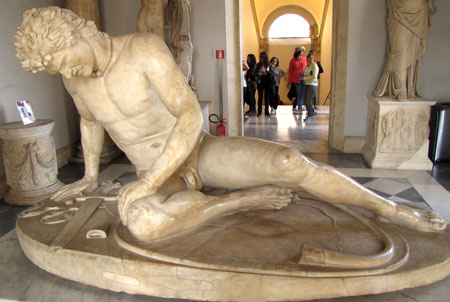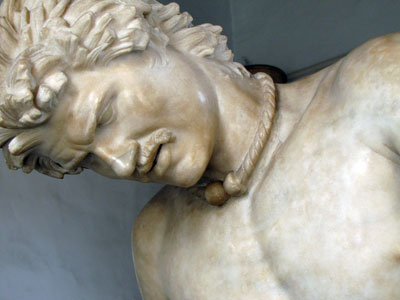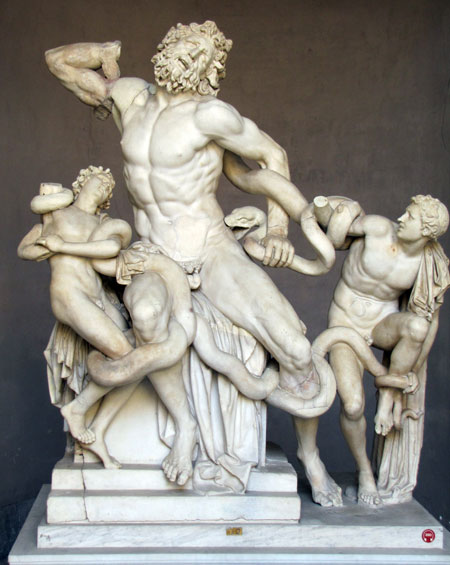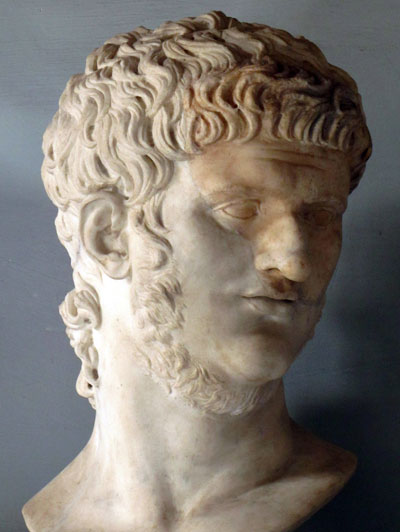|
|
|
|
Roman Statues and Busts
When the Romans conquered Greece in 146BC, they were
amazed by the quality of scuplture they found there, and took many of the
statues and reliefs back to Rome. Sculptors were inspired by the Greek
style, which was much more realistic and lively than anything they had
ever seen. The Greeks often used marble, a stone of very fine quality
which allows for great detail in the carving. Bronze was also excellent
for statues, but few bronze statues survive from ancient times because it
either rusted or was melted down to be used by someone else. The best work
was from about 300 years before the conquest, in the time of great sculptors like
Pheidias and Praxiteles. Many of the best Roman statues are copies of
these earlier Greek originals, which were sadly lost.
Roman statues and busts usually show a person, either real - such as an emperor or noble man or woman - or divine - i.e. a god. Many other subjects were carved too - animals, everyday objects like vases, and scenes from Roman (i.e. Greek) mythology. The bronze statue below is very famous - it shows the wolf which according to legend suckled Romulus and Remus, the founders of Rome. In fact the babies were much later in the middle ages.
Nero (ruled AD 54-68) - one of the bad emperors |
 The Roman Style The Romans were the first to carve statues or busts of
real people which actually looked like them - which showed them in all
their often quite ugly detail. The Egyptians had tried this with some of
their pharaohs, and the Greeks had gone further, but with Roman statues
there is often no mistaking who the person is meant to be. There are
hundreds of statues or busts of particular emperors, which are instantly
recognisable. This is nice because it means we know exactly what famous
Romans like Augustus or Nero looked like, as well as their hairstyles, clothing or armour.
|
|
Emperor Trajan (ruled AD 98-117) - one of the good ones
|
 Marcus Aurelius (ruled AD 161-180) - another of the good emperors. This is an amazing bronze statue which was gilded (covered in a thin layer of gold). |
|
A bronze statue known as the Hellenistic Prince, although he may be an athlete, given all those muscles.
|
 The famous 'Dying Gaul', sitting on his shield after a fatal battle wound.  Close up of the Dying Gaul. You can see the torc around his neck, and his hair spiked up with lime. |
|
Mythological Statues |
|
 Diana, goddess of hunting (borrowed from the Greek goddess Artemis) |
 The famous Apollo Belvedere Apollo was the twin brother of Artemis and god of light, the sun, music, poetry, medicine, and prophecy. |
 The god Mercury - messenger of the gods Mercury had wings on his feet to let him fly. To the Greeks he was known as Hermes. |
 Hercules - the strongest man who ever lived. He is shown with his club and lion skin. The Greeks called him Heracles. |
 A centaur - half man half horse, from Greek mythology. This and the Laocoon statue to the right show the intense emotion the Romans could put into their carving. |
 The Laocoon statue This is a scene from the myth of the Trojan war. The Greeks have left the wooden horse on the beach with soldiers hidden inside. Laocoon, a priest, tries to warn the Trojans - beware Greeks bearing gifts, he says. The goddess Athena helps the Greeks by sending snakes to kill Laocoon and his sons. This really is a spectacular work of art - the suffering is very clear in the expression and twisted bodies of the poor victims. |




